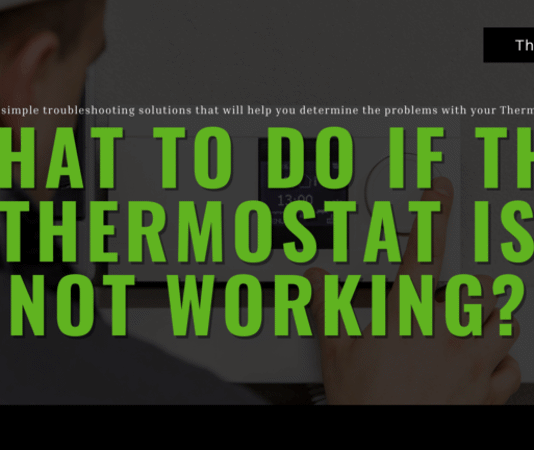What to Do if the Thermostat Is Not Working
AC Troubleshooting Guide: Fixing your Thermostat
A thermostat (also known as tstat) is a crucial component of any heating or cooling system, allowing you to maintain a comfortable temperature in your home or office. However, like any other device, thermostats can malfunction or stop working altogether, leaving you with an uncomfortable environment. A malfunctioning thermostat can cause a lot of discomfort and inconvenience, making it necessary to troubleshoot and fix the problem as soon as possible.
Fortunately, fixing a malfunctioning thermostat is not rocket science. In this guide, we will discuss five essential steps to troubleshoot and repair a malfunctioning thermostat, ensuring a comfortable and energy-efficient home or office. We will cover everything from checking the power to replacing the thermostat, providing you with the knowledge to diagnose and fix the problem. By following these steps, you can avoid costly repairs and keep your heating and cooling systems running smoothly.
5 Simple Steps to Fixing your Thermostat | AC Troubleshooting
Step 1: Check the Power
The first step in troubleshooting a malfunctioning thermostat is to check if it is receiving power. If the thermostat is battery-powered, try replacing the batteries. It’s essential to use fresh batteries as old ones may not provide enough power to the tstat, causing it to stop working. If the thermostat is wired, check the circuit breaker to ensure it has not tripped. Tripped breakers are a common cause of power loss in thermostats, and resetting it may solve the problem. A common reason why your thermostat might have gone blank is if the float switch is full of water, meaning that the drain line is clogged. Unclogging the drain line will allow power back into the thermostat.
Step 2: Check the Settings
Once you’ve ensured that the thermostat is receiving power, check the settings. Verify that the thermostat is set to the correct temperature and heating/cooling mode. Sometimes, the tstat may be set to the wrong temperature, causing it not to turn on the heating or cooling system. Ensure that the thermostat is in the correct mode; for instance, if it’s winter, the tstat should be in heating mode, and if it’s summer, it should be in cooling mode. The fan mode should be on Auto, this way your AC’s fan stops once the desired temperature is reached.
Step 3: Check the Wiring
If the thermostat is wired, it’s essential to check the wiring connections to ensure they are correctly connected and not loose or corroded. Loose or corroded wires can cause the thermostat not to receive power, making it ineffective. Check the wiring behind the tstat and at the furnace or air conditioning unit. Ensure that all wires are securely attached to their terminals and are not frayed or damaged. If you find any damaged wires, it’s best to replace or reconnect them as soon as possible. If there was a damaged wire it is likely that he fuse was blown, in this case the fuse would need to be replaced it can be found inside of the air handler.
Step 4: Clean the Thermostat
Over time, thermostats can collect dust and debris, making them ineffective. Remove the cover of the thermostat and clean the inside using a soft brush or compressed air to remove any dust or debris. Be sure to remove any visible dirt or debris on the thermostat’s faceplate, as this can interfere with the temperature sensor, making it ineffective.
Step 5: Replace the Thermostat
If none of the above steps work, the thermostat may need to be replaced. A malfunctioning thermostat can cause a lot of discomfort and inconvenience, making it necessary to replace it as soon as possible. When replacing a tstat, it’s essential to consider compatibility with your heating or cooling system. If you have a heat pump system you would need a 2 Heat 1 Cool tstat, if you have a straight cool or furnace system you only need a 1 Heat 1 Cool tstat. For a more advanced multizone or multistage system you might need a 3 Heat 2 Cool tstat. Consult the manufacturer’s instructions or contact a licensed HVAC professional to assist with the replacement.
Do problems persist? Call your HVAC technician today!
In conclusion, a malfunctioning thermostat can be a significant inconvenience, leaving you with an uncomfortable living or working space. However, by following the five essential steps outlined in this guide, you can troubleshoot and fix the problem with ease, saving you time and money.
If you’re unsure about any of the steps or feel uncomfortable working with electrical systems, it’s best to contact a licensed professional for assistance. At The AC Therapist, we specialize in providing high-quality HVAC services, including thermostat troubleshooting and repair. Our team of licensed professionals has the knowledge and expertise to diagnose and fix any thermostat problem, ensuring your heating and cooling systems are running smoothly.
We understand the importance of a comfortable living or working environment, and we strive to provide exceptional service to all our clients. Contact us today to learn more about our services or schedule an appointment with one of our experts. Let us help you keep your home or office comfortable and energy-efficient all year round.









